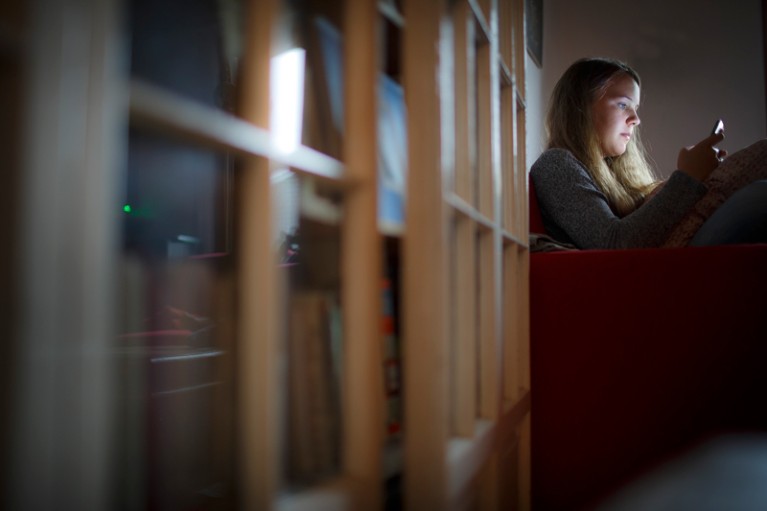
How much screen time is too much for teenagers? It’s complicated.Credit: Ute Grabowsky/Photothek/Getty
It has become a defining question of our age: do children and adolescents spend more time than is healthy staring at a phone, tablet or computer? Should parents limit their access? Should governments?
Nearly all US teenagers say they have access to a smartphone, and about half say they are online almost constantly, according to a 2018 Pew Research Center survey (see go.nature.com/2akajas). In the United Kingdom, the time young people spend online has almost doubled over the past decade, the communications-industry regulator, Ofcom, has found (see go.nature.com/2hd0c4p). Parental concerns about media use are rising, too — fuelled by headlines and political pronouncements. On 2 October 2018, Matt Hancock, UK secretary of state for health, issued an urgent warning, saying that the threat to children’s mental health from social media is similar to that from sugar to their physical health.
In cases of such significant public concern, it often falls to the scientific community to provide and assess evidence, and then make some recommendations. But scientific research in this field has its own challenges, and almost as many uncertainties.
Current evidence for an association between digital-technology use and adolescent well-being is contradictory and comes mainly from household panel surveys and other large-scale social polls, with thousands to millions of respondents. The questions represent a compromise between usefulness and not placing too much burden on respondents. They are simplified, are not standardized and often do not map straightforwardly onto the validated instruments that clinical or social scientists use to measure constructs such as ‘well-being’ and ‘technology use’.
So, researchers using these data to answer questions about the effects of technology need to make several decisions. Depending on the complexity of the data set, variables can be statistically analysed in trillions of ways. This makes almost any pattern of results possible. As a result, studies have suggested both the existence of and the lack of an association between screen time and well-being, even when analysing the same data set. Naturally, it’s the research that highlights possible dangers that receives the most public attention and helps to set the policy agenda.
A study published this week in Nature Human Behaviour (A. Orben and A. K. Przybylski Nature Hum. Behav. https://doi.org/10.1038/s41562-018-0506-1; 2019) introduces a different approach. The authors examine three key large-scale data sets, two from the United States and one from the United Kingdom, that include information about teenager well-being, digital-technology use and a host of other variables. Instead of running one or a handful of statistical analyses, they run all theoretically plausible analyses (combinations of dependent and independent variables, with or without co-variates) — in the case of one data set, more than 40,000. This allows the authors to map how the association between digital-technology use and well-being can vary — from negative to non-significant to positive — depending on how the same data set is used.
The authors’ overall calculations did find a statistically significant negative association between technology use and well-being: more screen time is associated with lower well-being in the young people surveyed. But the effects are so small — explaining at most 0.4% of the variation in well-being — as to be of little practical value.
To put this into context, the authors also looked at the associations between well-being and a range of other variables, such as binge drinking, being bullied, smoking, getting enough sleep, eating breakfast, eating vegetables, wearing glasses or going to the cinema. Well-being was more strongly associated, either positively or negatively, with most of these other variables than with digital-technology use. In fact, regularly eating potatoes was almost as negatively associated with well-being as was technology use, and the negative association between wearing glasses and well-being was greater.
This article is hardly the final word: its conclusions rely on the examination of associations, rather than on potential causal relationships. However, it does suggest that dire warnings are not warranted. And it is a reminder that limited evidence can distort public discourse when the issue is of pervasive significance — such as when parental decisions and the health of children are involved. This is also the conclusion reached by the UK Royal College of Paediatrics and Child Health, in guidance on the health effects of screen time that it issued earlier this month.
The digital revolution is without doubt changing modern life. We need more and better data to work out what impact that is having: in this case, whether media use causes reduced well-being, whether reduced well-being causes greater media use or whether a third variable underlies both. In the meantime, the findings of this study put the association between adolescent technology use and well-being in perspective, and highlight the importance of robust analytical techniques for social big data.

 The association between adolescent well-being and digital technology use
The association between adolescent well-being and digital technology use
 Searching for digital technology’s effects on well-being
Searching for digital technology’s effects on well-being
 How automation is changing work
How automation is changing work





